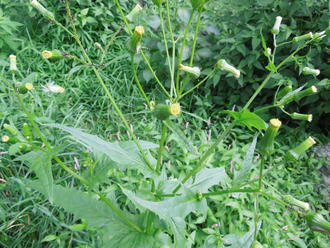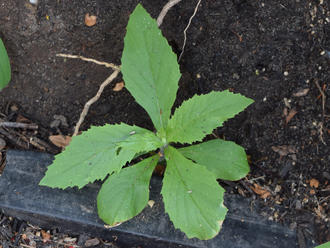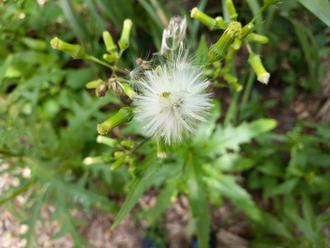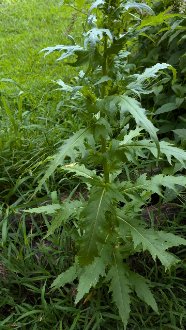American Burnweed (Erechtites hieraciifolius (L.) Raf. ex DC.)
Also known as fireweed, pilewort; also classified as Erechtites hieraciifolia (Spelling Error), Erechtites hieracifolia (Spelling Error), Senecio hieraciifolius L.
↑Summary
A tall annual native to eastern North America, a pioneer species on sites with soil disturbed during the warm season.
↑Range - Expand
| Legend | Color |
| Native | |
| Introduced | |
| Native or Not Present | |
| Introduced or Not Present |
This tentative map is based on our own research. It may have limited data on Canada and/or Mexico, and there is some subjectivity in our assignment of plants as introduced vs. expanded. Read more in this blog post.
Although this plant occurs somewhere in each of these regions, it may only occur in a small part of some or all of them.
↑Description & Identification
This plant's size is highly variable, depending on moisture, light levels, and nutrient availability. Mature plants can range from 1cm to 2.5m (8ft) in height.
↑Similar Plants
↑Habitat
American burnweed is one of the most abundant plants in most of its range, and is found on sites with disturbed soils in a range of different habitats. Natural habitats include sites of recent wildfires, shorelines or margins of ponds, lakes, or wetlands that have experienced a recent drop in water level, and gaps in forests. It is often abundant in anthropogenic habitats, including along roadsides and railroads, in agricultural land, gardens, and weedy patches in urban and suburban areas.
The one thing required for this species is soil exposed to sunlight during the warm portion of the growing season. In all other areas it is a broadly-adaptable generalist. It favors, but is not limited to moist areas. It tolerates full sun to light shade, but always requires some direct sunlight. In the southern portions of its range, it becomes more restricted to moister, shaded habitats. It occurs in a range of soil types, including sandy, clay, loamy, rocky, and gravely soils. It tolerates salinity up to 0.5%, and a wide range of pH, including both acidic and alkaline soils.
It is frequently found where fire has occurred, but does not depend on fire and also occurs in habitats that never burn, taking advantage of many other types of disturbance including drought, gaps. Humans have increased its habitat and numbers through various types of disturbance including mowing, herbicide use, and weeding.
↑Life Cycle
This plant is a summer annual.
It sprouts from seed in late spring to early summer. Seeds are small and need significant moisture and sunlight to establish. Early sprouting plants may grow for a short time as a basal rosette, but it usually begins growing upright rather soon. Seedlings are initially intolerant of competition but once the plant starts growing upright, plants become highly competitive. Plants usually do not branch until flowering, although plants will branch in response to being cut or having their tops removed or broken off. Plants usually grows continually in height until flowering. On favorable sites, lower leaves are fully retained, but lower leaves can be shed in the case of drought and/or heavy shading.
Flowers are inconspicuous and primarily wasp-pollinated. Seeds are wind-dispersed, often carried over long distances, and usually germinate only after cold dormancy. Plants are often poor at optimizing seed production and often end the growing season with an excess of photosynthetic capacity that cannot be put into seeds; the excess energy can be taken up by the mychorrizal network, and some of it will be available to other plants in the next year. Frost tolerance is poor and plants are usually killed by frost.
It is not known how long this species persists in the seed bank, and there is conflicting evidence on this topic. There has been evidence of high germination rates in seeds as old as 8 years, but in many circumstances, seeds seem to originate from newer, wind-dispersed seeds rather than seeds persisting in the soil.
Ecologically, this plant is an early-successional plant, and its populations are usually short-lived in the absence of repeated disturbance. It tends to be replaced by perennial vegetation on undisturbed sites.
↑Faunal Associations
Mammalian herbivores usually ignore this plant because of the bitterness and strong aroma of the foliage, but it supports a wide variety of insect herbivores.
The larvae of the moth Palthis asopialis, which eats many different species, has been reported feeding on this plant. The larvae of the moths Phyllocnistis insignis and Phytobia maculosa feed as a leaf miner on this and a few closely-related plants. The larvae of the flies Liriomyza sativae and Liriomyza trifolii also eat this plant, among many others.
The generalist Tarnished Plant bug Lygus lineolaris also feeds on this plant. Gall midges (Neolasioptera sp.) have also been reported on this plant.
The aphid Brachycaudus helichrysi, best-known as a pest of plum trees, also has been recorded feeding on this plant.
The flowers primarily attract wasps, but occasionally other pollinators.
↑Control
This plant is an important part of the ecosystem in areas where it is native, and does not need to be controlled. It tends to be self-limiting, and will rarely dominate on sites unless you are persistently disturbing the soil during the growing season, but even when it dominates it does not usually cause any harm.
However, because it is weedy and aggressive, it has high invasive potential outside its native range. It has formed sustaining wild populations on the West Coast of North America, in and near Central Europe, in South And Southeast Asia, and in Australia and New Zealand.
It has also developed resistance to the herbicide 2,4-D.
When growing outside its native range, it can be controlled by removing plants before they flower and make seeds. Cutting plants to the ground right before they start flowering is usually effective because if plants resprout at all, their seed production will be minimal. Pulling plants earlier in the growing season is usually not effective because new seedlings can reestablish in response to the disturbed soil.
In large infestations where it is not feasible to remove all plants, the most effective approach is to target the most vigorous plants as they produce an overwhelming majority of seed. Smaller individuals growing on drier sites and/or sites with poorer soil make produce a negligible amount of seed.
In the long-run, taking care to minimize soil disturbance, and establishing thick cover of native perennials and/or woody vegetation, can prevent the spread and/or reestablishment of this plant.
↑Uses
This plant has historically had medicinal uses but is not widely used nowadays. It is usually described as edible but with a strong flavor that many people find unpleasant, so it is rarely eaten and when eaten, it is usually used in small quantities.
Plants are effective at absorbing nitrogen oxides, a common atmospheric pollutant especially in areas with a lot of vehicle traffic.
This plant is also effective at controlling erosion and often establishes on its own, particularly along shorelines of bodies of fresh water during times of drought. It is also effective at revegetating disturbed sites and preventing the establishment of disturbance-loving invasives.
↑Related Plants
There are numerous other Erechtites species, mostly native to south and Central America. With the taxonomic scheme we use, no other Erechtites species occur in the US or Canada, but two other species, E. valerianifolius and E. runcinatus, are native to Mexico.
More broadly, this genus belongs to the Senecioninae subtribe. This grouping contains many genera, the best-known of which is Senecio, of which there are both native and introduced species in North America.
↑Links & External Resources
• Erechtites hieraciifolius (American Burnweed) | USDA PLANTS Database (About This Site)
• Erechtites hieraciifolius | Go Botany (About This Site)
• Senecio hieraciifolius | Biota of North America Project (BONAP) (About This Site)
• Erechtites hieraciifolius | NatureServe Explorer (About This Site)
• Erechtites hieraciifolius | Flora of North America (About This Site)
• Erechtites hieracifolia (Pilewort) | Illinois Wildflowers (About This Site)
• Erechtites hieraciifolius | Missouri Plants (About This Site)
• American Burnweed | Maryland Biodiversity Project (About This Site)
• Erechtites hieraciifolius (Pilewort) | Minnesota Wildflowers (About This Site)
• Erechtites hieraciifolius (L.) Raf. ex DC. (Fireweed, Pilewort, American Burnweed) | Digital Atlas of the Virginia Flora (About This Site)










